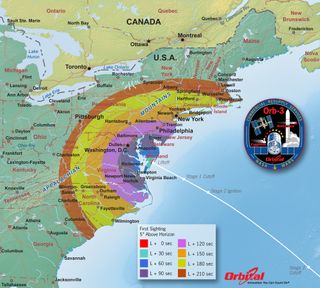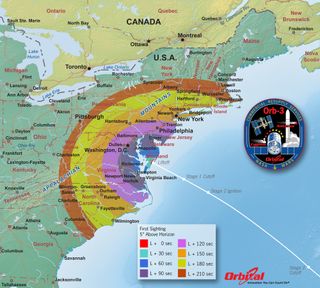
UPDATE for Monday, 6:53 pm ET: A stray boat in the launch range forced Orbital Sciences to postpone Monday's Antares rocket launch. The launch is now set for Tuesday, Oct. 28, at 6:22 p.m. EDT, with NASA's live webcast to begin at 5:30 p.m. EDT. Full Story: Private Rocket Launch to Deliver Space Station Supplies Delayed by Boat .
If you live along the U.S. East Coast, you have a great opportunity to see a rocket launch from your own backyard Monday evening (Oct. 27), but you'll need to know when and where to look to spot the brilliant liftoff.
Early Monday evening, a commercial Antares rocket built by the Orbital Sciences Corp. is due to blast off at 6:45 p.m. EDT (2245 GMT) from a pad at the Mid-Atlantic Regional Spaceport on Wallops Island, Virginia. It is the first-ever night launch of the two-stage Antares rocket, and the flight could be visible from Massachusetts to South Carolina, weather permitting.
You can watch the Antares rocket launch live on Space.com beginning at 5:45 p.m. EDT (2145 GMT). But spectators on the U.S. East Coast should be sure to be looking in the right direction to see the launch. [How to See the Antares Rocket Night Launch (Visibility Maps)]
The Antares rocket will launch an Orbital-built Cygnus spacecraft on Orb-3, the third official cargo delivery mission to the International Space Station for NASA under a $1.9 billion deal. If all goes well, the robotic Cygnus spacecraft should arrive at the station on Nov. 2 to deliver nearly 5,000 lbs. of supplies.

What to expect
Views of Monday night's rocket launch will be different depending on where you live on the East Coast. The further away you are from the launch site, the closer to the horizon the rocket will appear during its ascent. As a reference, your clenched fist held at arm's length is roughly 10 degrees in width.
If a skywatcher is trying to spot the launch from Philadelphia, for instance, the highest point the Antares rocket will reach is approximately 13 degrees above the horizon. It's unlikely that an observer will be able to view the launch when it's below 5 degrees above the horizon because buildings, vegetation, and other terrain features will probably get in the way.
Get the Space.com Newsletter
Breaking space news, the latest updates on rocket launches, skywatching events and more!
Editor's Note:If you snap a photo of the rocket launch and want to share it with Space.com, you can send in images and comments to: spacephotos@space.com.
As seen from Philadelphia, Orbital Sciences' Antares will reach 5 degrees above the horizon about 100 seconds after launch.

Antares' launch will be visible along the East Coast by virtue of the light emitted from its two stages. The first stage uses kerosene and liquid oxygen as propellants, powering two Aerojet AJ-26 engines, which are modified Russian-built NK-33 engines originally developed for Russia's N-1 moon rocket.
Antares should appear as a bright, moving star. Observers who use binoculars might be able to see a tiny V-shaped contrail. Because the first stage of Antares is liquid fueled, its ascent is slower than the Minotaur rockets that have launched from Wallops in recent years.
At approximately 180 seconds after launch, the spacecraft will have risen to an altitude where it will begin to be illuminated by the sun which could make it appear brighter. Antares will jettison its first stage once it has spent all its fuel, 239 seconds after launch. This harmlessly breaks up in the atmosphere and falls into the Atlantic Ocean.
Then comes a coasting phase, which lasts about 47 seconds after the first stage shutdown; the sunlit rocket should continue to be visible, followed by ignition of the second stage, 4 minutes 41 seconds after liftoff. The second stage is a solid-fuel rocket, the Castor 30XL.

A bright rocket contrail
Antares' altitude at this point will be 86.9 miles (139.8 kilometers). At this height the resultant exhaust trail from its Castor 30XL upper stage motor will be illuminated by sunlight possibly leaving a long, glowing contrail in its wake. While many West Coast residents may be quite familiar with such launch sightings by Minotaur rocket launchings emanating from California's Vandenberg Air Force Base, they are very rare in the East, and as such may end up surprising millions of people if Antares launches on schedule on Monday evening. [Spotting Spaceships and Satellites from Earth (Photos)]
The rocket's second stage will burn for 166 seconds and then, along with the Cygnus cargo ship, Antares will be put into a low-Earth orbit. Once it separates from the second stage 9 minutes, 27 seconds after launch, Cygnus will then use its own engines to continue on its own for its mission to the International Space Station.
The second stage will appear farther downrange and at a lower elevation than where the first stage shutdown appeared. The trajectory appears to dip back toward Earth as the rocket moves further away from the observer and disappears beyond the horizon. The rocket of course, is not returning to Earth — it is continuing its ascent, speeding higher and faster toward space.
Where to look
- Eastern Half of South Carolina/North Carolina/Coastal Virginia: Liftoff to Stage 1 shutdown, primarily toward the northeast. Stage 2 ignition, for the Carolinas, east; coastal Virginia, southeast.
- Interior Virginia/Eastern half of West Virginia: Liftoff to Stage 1 shutdown, primarily toward the east. Stage 2 ignition, southeast.
- Maryland, Delaware, Pennsylvania: Liftoff to Stage 1 shutdown, primarily south-southeast. Stage 2 ignition, southeast.
- New Jersey/Southeast New York: Liftoff to Stage 1 shutdown, south. Stage 2 ignition, southeast.
- Southern New England and Long Island: Liftoff to Stage 1 shutdown, south-southwest. Stage 2 ignition, for Western Massachusetts, Connecticut and Long Island, southeast; for eastern Massachusetts and Rhode Island, south-southeast.
Viewing Details
Public viewing of the launch will be available at the NASA Visitor Center at Wallops. For more information about the Visitors Center, to include directions, see: http://www.nasa.gov/centers/wallops/visitorcenter/index.html#.UqipAqV1TqA
For any questions about viewing the launch from the Visitor Center, call: 757.824.1344.
For updates on the launch, call: 757.824.2050.
The Chincoteague National Wildlife Refuge/Assateague National Seashore will not be open to watch the launch.
Android users can download the new "What's Up at Wallops" app, which contains information on the launch as well as a compass showing the precise direction for launch viewing. The app is available for download at:http://go.nasa.gov/17veCYT.
Orbital Sciences has named its Orb-3 Cygnus spacecraft the SS Deke Slayton in tribute to original Mercury 7 astronaut Donald "Deke" K. Slayton, who flew on the Apollo-Soyuz Test Project mission in 1975 and championed commercial space endeavors after retiring from NASA in 1982. Slayton passed away in 1993.
The Orb-3 mission follows cargo launches in January and July, and a test flight to the station in April 2013. Under its $1.9 billion contract, Orbital Sciences has five more cargo runs to the orbiting outpost for NASA.
The California-based company SpaceX also has its own $1.6 billion contract with NASA to provide 12 cargo missions to the space station using its own Dragon spacecraft and Falcon 9 rockets. The fourth Dragon mission under that contract came to a successful end on Saturday (Oct. 25), when the unmanned Dragon capsule returned to Earth after just over a month at the station
Joe Rao serves as an instructor and guest lecturer at New York's Hayden Planetarium. He writes about astronomy for Natural History magazine, the Farmer's Almanac and other publications, and he is also an on-camera meteorologist for News 12 Westchester, N.Y.Follow us @Spacedotcom, Facebook and Google+. Original article on Space.com.
Join our Space Forums to keep talking space on the latest missions, night sky and more! And if you have a news tip, correction or comment, let us know at: community@space.com.

Joe Rao is Space.com's skywatching columnist, as well as a veteran meteorologist and eclipse chaser who also serves as an instructor and guest lecturer at New York's Hayden Planetarium. He writes about astronomy for Natural History magazine, the Farmers' Almanac and other publications. Joe is an 8-time Emmy-nominated meteorologist who served the Putnam Valley region of New York for over 21 years. You can find him on Twitter and YouTube tracking lunar and solar eclipses, meteor showers and more. To find out Joe's latest project, visit him on Twitter.
